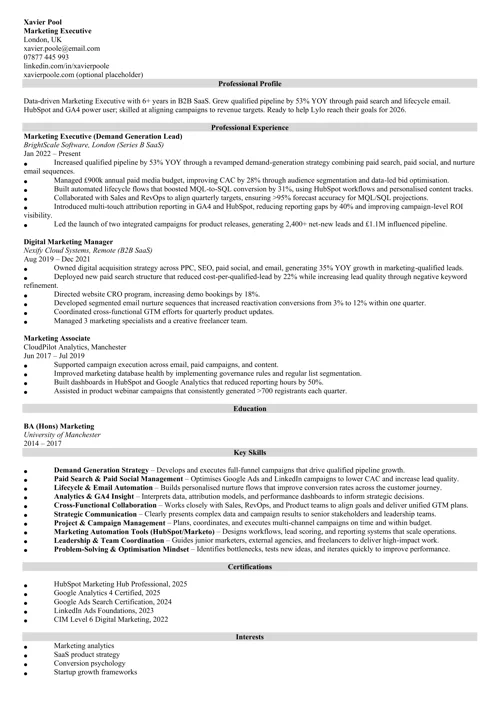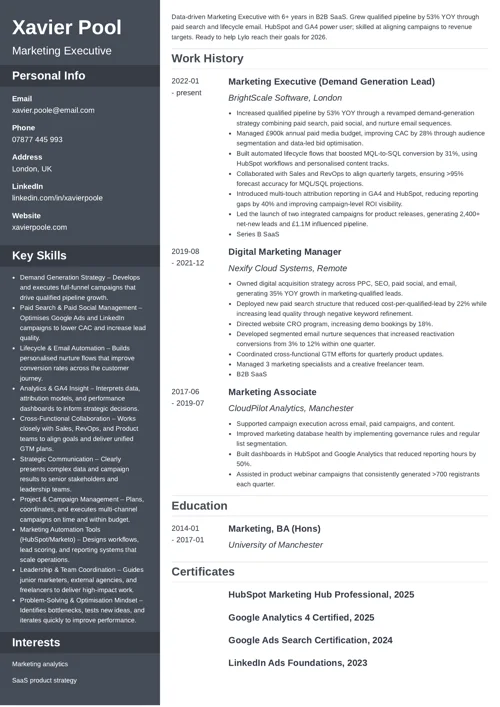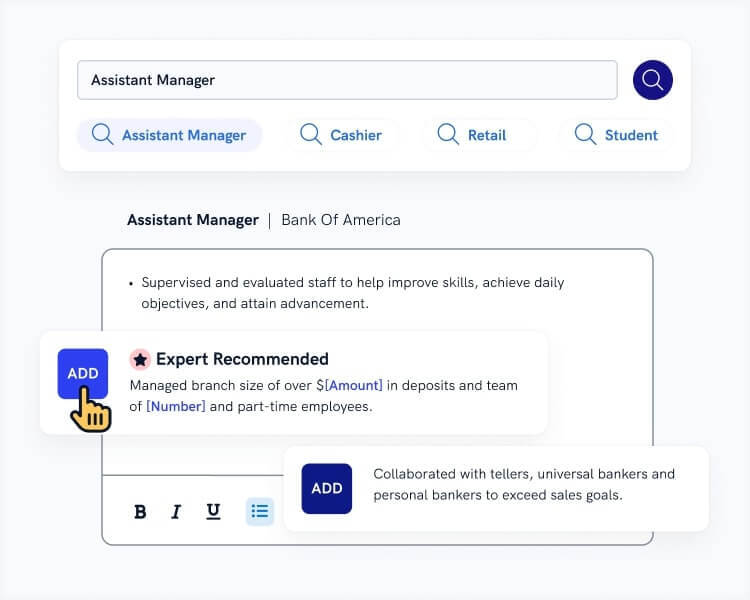How to Write a CV Introduction in 2026: Examples
Create your CV nowStaring at a blank page and unsure how to start your CV? You’re not alone. The reality is, the most effective way to begin your CV is to write the introduction after completing the rest. Once you've detailed your skills, experience, and achievements, it becomes much easier to craft a compelling opening that emphasises your strongest points.
Let me guide you on creating a good CV introduction, customising it to the job, and supporting it with evidence.
Want to save time and have your CV ready in 5 minutes? Try our CV builder. It’s fast and easy to use. Plus, you’ll get ready-made content to add with one click. See 20+ CV templates and create your CV here.
Sample CV made with our builder—See more templates and create your CV here.
One of our users, Nikos, had this to say:
[I used] a nice template I found on Zety. My CV is now one page long, not three. With the same stuff.
Check other tips that will help you overcome writer’s block:
What is a CV introduction? (and why it matters)
A CV introduction is the 3–5 line opening statement at the top of your CV. It aims to describe who you are, where you add value, and why you’re a fit for the job. It should be tailored, concrete, and easy to skim.
Done well, an introduction to a CV answers the two recruiter questions: Can you do the job? Will you help us hit our goals? Think of it as the elevator pitch for your whole CV.
Now that you know what the intro does, let’s choose the right type for your career stage and target role.
💡 Hungry for more definitions? Read our guide: What Is a CV?
Types of CV introductions: Which one is right for you?
Remember, the first impression matters: like in a meeting, starting with “what's up?” sets the wrong tone. The same applies to your CV. Focus on your message and strengths, then pick a format that showcases them quickly. Ensure your format matches your CV layout and industry expectations.
Choosing the correct type of CV intro simplifies the process. Use the breakdowns below to select a format that makes your opener irresistible.
CV profile
A CV profile is the UK’s standard: a concise paragraph that highlights your work experience and value. Use it when you have relevant experience and clear, measurable proof points. Think of it as a trailer for your CV: it’s specific, professional, and closely aligned with the job advert.
- What it is: A 3–5 line snapshot of your value.
- Best for: Most roles in the UK job market, especially professionals with several years of relevant experience or a clear career path.
- Include: Job title, years of experience, one to two key results, core skills, tools you’re proficient in, and a goal linked to the employer.
Here’s a CV profile example from a marketing CV, executive level:
Data-driven Marketing Executive with 6+ years in B2B SaaS. Grew qualified pipeline by 53% YOY through paid search and lifecycle email. HubSpot and GA4 power user; skilled at aligning campaigns to revenue targets. Ready to help Lylo reach their goals for 2026.
This example measures impact with a clear percentage, mentions tools and the SaaS domain, and directly connects activities to commercial results. And that’s precisely how you make your recruiter spend more than the average 7 seconds on your application.
Career objective
A career objective focuses on the future, which is ideal when your experience doesn’t exactly match. Lead with relevant studies, projects, and transferable skills, then outline a goal that aligns with the advertisement. Keep it practical and employer-focused rather than personal or generic.
- What it is: A forward-looking statement focused on your target role.
- Best for: Little to no experience, returning to work, or a career-change CVs.
- Include: Relevant study/projects, transferable skills, tools, and a goal that mirrors the advert.
Here’s a career objective example for an internship CV:
Motivated and detail-oriented English Literature student seeking to apply strong writing and communication skills in a journalism internship. Authored three award-winning articles for the university paper and contributed a guest blog post that attracted over 100,000 views in one month. Keen to develop interviewing and research skills as part of the editorial team at The Today Gazette.
This internship CV introduction shows how relevant accomplishments and ambition can create a strong first impression, even without formal work experience.
Here’s an example from a career-change CV:
Accomplished marketing specialist with 4 years in digital campaigns and social media management, now looking to transition into the non-profit sector. Eager to apply creative problem-solving and outreach expertise to help Lylo increase awareness and fundraising for a local charity through cost-effective digital marketing initiatives.
Although this candidate is moving into a different sector, the objective emphasises transferable skills and how they’ll bring value in the new role, making it relevant to the position they’re after.
Summary of qualifications
If you want instant scannability, a qualifications summary turns your top highlights into punchy bullets. It’s convenient when your achievements are discrete and quantifiable.
- What it is: A short, sharp list of your most impressive skills, achievements, and experience.
- Best for: Mid- to senior-level applicants who want a quick-scan alternative to a paragraph.
- Include: 4–5 bullets mixing scope (teams/budgets), standout results, core tools, and an aligned goal.
Here’s a summary of qualifications example from a project manager's CV:
- Over 5 years of experience managing high-level projects with cross-functional teams
- Strong relationship-building and stakeholder management skills
- Delivered projects at least £10K under budget and 10% ahead of schedule
- Seeking to bring project leadership expertise to the senior team at Blueproject
Simple. Select the 4–5 strongest highlights from your CV and reword them as punchy bullets to grab attention fast, and you’ll end up with something as impressive as this summary.
Executive summary (go-to for senior managers and executives)
At the senior level, recruiters need scale and results at a glance. An executive summary uses bullets to surface scope, strategy, and measurable outcomes quickly. Keep each line loaded with numbers, proper nouns, and decision-making impact.
- What it is: A 3–6 bullet snapshot of scope, strategy, and standout wins.
- Best for: Senior roles where scale and leadership matter.
- Include: P&L, headcount, operations scale, strategy outcomes, and culture impact.
Here’s an executive summary example for an operations director:
- Led 480-person, multi-site ops across UK&I; £85m P&L
- Cut fulfilment costs 22% while improving OTIF to 98.4%
- Automated S&OP; reduced stockouts 31%
- Built first-line leader academy; +18% engagement
This candidate has shown some hard numbers. They demonstrate efficiency and quality. Bullet points quickly highlight senior scale and make it easier for recruiters to scan a CV.
CV headline
Struggling to fit your career highlights onto one or two pages? You can also include a concise title under your name, slightly longer than a typical job title. A CV headline provides a clear identity line just below your contact details. It isn’t a complete sentence; it's more of your professional billboard.
- What it is: A concise phrase summing up your professional identity.
- Best for: Any level when space is tight or you want instant positioning.
- Include: Role/level + key credential/achievement or niche.
Here are some CV headline examples for different professionals:
- Marketing Manager with 7+ years’ experience | Clio award winner
- OSCP-Certified cybersecurity specialist with 5 years’ hands-on expertise
- Project Manager known for delivering projects 10% ahead of schedule
- Bilingual Healthcare Assistant | CPR & BLS Certified | Skilled in Team Leadership
Short, specific, and packed with value. A strong headline creates a positive first impression at a single glance.
💡 Pro tip: Treat the CV Headline as an optional add-on, not a replacement.
How to write a CV introduction: formula, dos and don’ts
A blank page is the biggest blocker. However, there’s a simple way to fill it with an impressive introduction. Let’s start with the basics.
📌 Here's how to write a CV introduction:
- Scan the job ad and highlight 3–5 must-have skills and keywords.
- Pick one positioning word. Look for results-focused, customer-centred, hands-on, etc.
- Select 2–3 proof points: numbers, tools, scope (budget, headcount).
- Mirror the employer’s language and use their keywords naturally.
- Trim for punch. Aim for ~60–120 words (or short bullets for execs).
But there’s also a straightforward formula you can follow:
Adjective + Job Title + Years + 2–3 Proof Points (metrics/tools/scope) + Career Goal
Here’s a sample CV introduction that follows this rule:
CV introduction example
Insight-driven Data Analyst with 4 years' experience in retail e-commerce and B2B Saas. Developed automated SQL/Python pipelines and Power BI dashboards that reduced reporting time by 45%, and delivered funnel analyses that decreased checkout drop-off by 9% and increased retention by 6 percentage points. Aiming to transform complex datasets into clear actions and support a product-led team in Lylo in implementing data-backed improvements more swiftly.
Impressive, relevant, simply perfect. But there’s one more critical aspect to it. It’s tailored to the job offer.
Tailoring isn’t optional—It’s what gets you past the first skim. Treat the ad like a checklist and cover the top requirements in the first one or two lines. If you can tick them off against your intro, you’re tailored enough.
📌 Here’s how to tailor a good CV introduction:
- List the top 5 job requirements and pair each with a proof point.
- Use exact phrases where natural. If the ad says stakeholder management, use it.
- Start with the most critical requirement.
- Echo their value: patient safety, net revenue, CSAT, and name it.
- Keep your tone confident, concise, and human, avoiding any buzzwords.
- Drop the company name to prove further that you’re after their offer, and not just any other one.
Seeing the transformation solidifies the rules. Here’s the first draft of a CV intro: is vague and employee-focused.
Hard-working professional seeking a new challenge in a dynamic company.
The tailored version is measurable and aligned with commercial outcomes.
CV introduction example tailored to the job
Results-focused Account Manager with 5+ years in telecoms. Grew enterprise revenue 28% YOY across 14 key accounts; negotiated two £1m+ renewals. Looking to drive upsell and retention in EMEA mid-market.
What changed? The candidate:
- mentioned their job title
- expanded on the scope
- included relevant figures
- aligned with the position’s priorities (revenue, retention).
- stated a goal that benefits the employer
It’s clear which approach works better.
Let’s do a quick recap on how to write a CV introduction.
✅ Do:
- Tailor to the job description and mirror its keywords.
- Prove value with numbers, tools, and scope.
- Keep it tight: 3–5 lines (or concise bullets for execs).
- Lead with the most relevant achievement.
- Use active verbs: delivered, led, improved, reduced.
❌ Don’t:
- Paste a generic paragraph into every application.
- Rely on clichés (team player, results-driven).
- List duties without outcomes.
- Overstuff with buzzwords or long sentences.
- State a goal unrelated to the role.
When making a CV in our builder, drag & drop bullet points, skills, and auto-fill the boring stuff. Spell check? Check. Start building a professional CV template here for free.
When you’re done, Zety’s CV builder will score your CV and tell you exactly how to make it better.
How to write a CV introduction with no experience?
No experience doesn’t mean no evidence. Pull from projects, modules, placements, volunteering, competitions, and society roles. Focus on outcomes, tools, and responsibilities that match the role, and then state a realistic, employer-centred goal.
📌 Here’s what to highlight when writing a no-experience CV introduction:
- Degrees, modules, capstone or bootcamp projects
- Tools and methods (Excel, Python, Figma, CRM, POS)
- Roles with responsibility (cash up, rota, events, lab)
- Measurable outcomes (views, sign-ups, savings, CSAT)
- Availability and flexibility (evenings/weekends)
Here’s an example from an administrator moving to graphic design:
CV introduction example
Detail-oriented administrator moving into graphic design. Completed a 6-month design bootcamp and built three portfolio case studies—brand identity, editorial layout, and campaign creatives—using Adobe Illustrator, Photoshop, InDesign and Figma. Led an intranet refresh (navigation, icons, page templates) that cut IT support calls by 19% and improved task completion in testing. Looking to bring organised, stakeholder-savvy delivery to a junior designer role at Lylo and craft on-brand visuals that lift engagement and reduce user friction.
Lead with what you’ve done, not what you lack, and then make your goal clearly valuable for the employer.
💡 Learn more about writing an entry-level CV: How to Write a CV with No Experience
Academic CV introductions in the UK
Academic CVs follow different conventions: emphasise breadth over brevity, and prioritise evidence over adjectives. Your introduction should clearly state your research focus, notable outputs, funding sources, and teaching responsibilities. Afterwards, guide readers through the sections below. Keep it concise but rich in content.
Focus your intro on:
- Research area and contribution (topic, methods, impact)
- Publications (counts; highlight first-author)
- Funding (grants, fellowships)
- Teaching (modules, supervision, innovation)
- Next step (lectureship, fellowship, postdoc focus)
Here’s an example of how to do it right:
Molecular biologist investigating epigenetic regulation in neurodegeneration. Co-author on six peer-reviewed papers (2 first-author); £120k co-applicant funding. Teaching experience across UG lab modules. Seeking lectureship combining research and supervision at the University of Bath.
Keep the intro succinct, then let the publications, grants and teaching sections do the heavy lifting.
💡 Read more: How to Write an Academic CV
Self-review checklist (tick before you send)
A quick checklist helps you avoid last-minute bloat. Read your intro aloud; if you stumble, it’s too long. If you can’t point to a number or a named tool, it’s too vague.
Checklist:
☐ First line states who you are and your value
☐ 2–3 proof points with numbers/tools/scope
☐ Keywords from the job ad appear naturally
☐ ~3–5 lines (or 3–6 bullets for executives)
☐ No clichés; strong verbs; no fluff
☐ Goal aligned to the employer’s needs
☐ Tone: clear, confident, human
If every box is ticked, your intro is ready to go!
💡 Make sure you’ve got it all right. Visit our guide: How to Write a CV
Plus, a great cover letter that matches your CV will give you an advantage over other candidates. You can write it in our cover letter builder here. Here's what it may look like:
See more cover letter templates and start writing.
Key takeaways
Let’s distil the essentials so you remember them under deadline pressure. Choosing the right type and tailoring to the advert are non-negotiable.
- Pick the right CV introduction type: Profile (most), Career Objective (grads/changers), Executive Summary (senior), or a summary of qualifications.
- Use the formula to draft fast; edit for clarity.
- Tailor with keywords and employer-centred goals.
- Lead with impact; keep it tight.
Nail these four, and you’ll outshine generic intros in any stack. Good luck. You’ve got this!
About Zety’s Editorial Process
Our editorial team has thoroughly reviewed this article to ensure it follows Zety’s editorial guidelines. Our dedication lies in sharing our expertise and providing you with actionable career advice that offers you real value. Every year, the quality of our content attracts 40 million readers to our site. But that’s not all – we conduct original research to gain a detailed understanding of the labour market. We take pride in being cited by top universities and leading media outlets in the UK and worldwide.
Sources
- John Taggart, “First Impressions Count: Self-Presentation in Qualitative Interviews“
- HR News, “Recruiters spend just 7 seconds on each application“
- Penn State CBusiness Career Center, "25 Transferable Skills Employers Look For"
Frequently asked questions about CV introductions
How long should my CV introduction be?
Aim for 3–5 concise lines, which usually amount to around 60–120 words. Senior candidates can use a short bullet snapshot (typically 3–6 bullets) if that makes it clearer. Anything longer tends to bury the hook and dilute impact. Do the five-second skim test: can someone quickly grasp your value and fit?
Should I write in the first or third person?
Use muted first person—write statements without “I” (e.g., “Delivered 12% growth”) rather than third person (“John delivered”). It reads cleaner, feels more professional, and avoids repetitive pronouns. Keep the voice consistent throughout your CV. Pair it with active verbs and short, direct sentences.
Is a CV introduction always necessary?
For UK CVs, an introduction or profile is strongly recommended, as it helps a recruiter understand your fit quickly. Academic CVs tend to be longer but still benefit from a brief research-focused profile at the top. The only reason to skip it is if the employer explicitly forbids or mandates a different format. Otherwise, a focused, relevant opener improves your chances of a thorough read.
Should I include keywords from the job description?
Yes. Naturally mirror the employer’s language, especially the top 3–5 requirements. Including a few high-impact keywords in your introduction helps both human readers and ATS filters. Don’t overdo it; weave them into proof points (“reduced churn,” “stakeholder management,” “GA4”). If it sounds robotic, you’ve gone too far.
Why should I tailor CV introductions each time?
You should customise your CV introduction each time because recruiters skim quickly, and a personalised opener highlights specific skills and results the employer seeks. It also aligns your language with the keywords from the job ad, helping both people and ATS spot your suitability immediately. Reordering your proof points and using the employer’s tools or priorities shows motivation, not just copy-pasting. In short: small edits boost relevance, create a stronger first impression, and increase interview chances.







